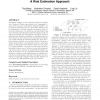Free Online Productivity Tools
i2Speak
i2Symbol
i2OCR
iTex2Img
iWeb2Print
iWeb2Shot
i2Type
iPdf2Split
iPdf2Merge
i2Bopomofo
i2Arabic
i2Style
i2Image
i2PDF
iLatex2Rtf
Sci2ools
202
Voted
SACMAT
2011
ACM
2011
ACM
Modeling data flow in socio-information networks: a risk estimation approach
Information leakage via the networks formed by subjects (e.g., Facebook, Twitter) and objects (e.g., blogosphere) − some of whom may be controlled by malicious insiders − often leads to unpredicted access control risks. While it may be impossible to precisely quantify information flows between two entities (e.g., two friends in a social network), this paper presents a first attempt towards leveraging recent advances in modeling socio-information networks to develop a statistical risk estimation paradigm for quantifying such insider threats. In the context of socio-information networks, our models estimate the following likelihoods: prior flow − has a subject s acquired covert access to object o via the networks? posterior flow − if s is granted access to o, what is its impact on information flows between subject s′ and object o′ ? network evolution − how will a newly created social relationship between s and s′ influence current risk estimates? Our goal is not to...
Computing And Information Systems | Control Systems | Information Systems Security | Risk Estimation | SACMAT 2011 |
Related Content
| Added | 17 Sep 2011 |
| Updated | 17 Sep 2011 |
| Type | Journal |
| Year | 2011 |
| Where | SACMAT |
| Authors | Ting Wang, Mudhakar Srivatsa, Dakshi Agrawal, Ling Liu |
Comments (0)

